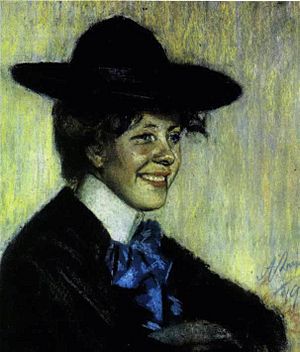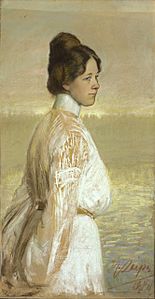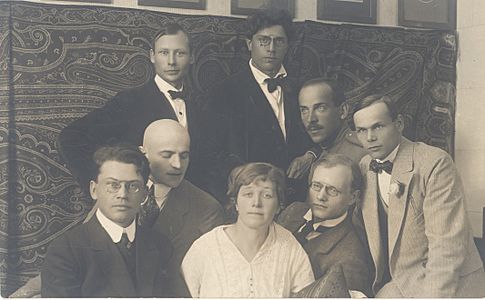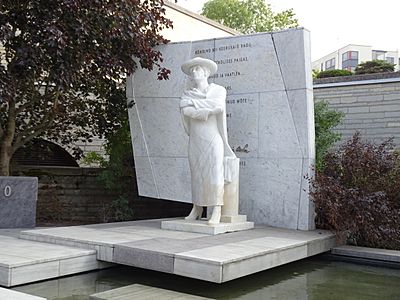Marie Under facts for kids
Quick facts for kids
Marie Under
|
|
|---|---|
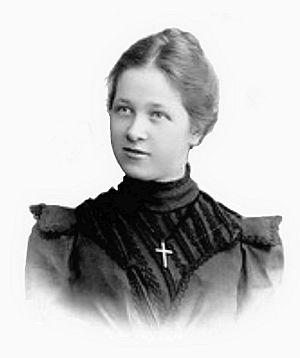
Marie Under circa 1899.
|
|
| Born | 27 March 1883 Reval, Governorate of Estonia, Russian Empire (present-day Tallinn, Estonia) |
| Died | 25 September 1980 (aged 97) Stockholm, Sweden |
| Nationality | Estonian |
| Literary movement | Siuru, Tarapita |
| Spouse |
Carl Hacker
(m. 1902; div. 1924)Artur Adson
(m. 1924; |
| Children | Dagmar Stock (1902–1994) Hedda Hacker (1905–1988) |
Marie Under (born March 27, 1883 – died September 25, 1980) was one of Estonia's most famous poets. She was so talented that she was nominated for the Nobel Prize in Literature eight times!
Contents
Early Life of Marie Under
Marie Under was born in Tallinn, Estonia. Her parents, Priidu and Leena Under, were both school teachers. She had two older siblings and two younger ones. Marie went to a private German girls' school. After school, she worked in a bookstore. In her free time, she loved to write poems in German.
In 1902, Marie married Carl Hacker, an accountant. They had two daughters, Dagmar and Hedda. They lived in a place called Kuchino, near Moscow. However, in 1904, she met an Estonian artist named Ants Laikmaa. He encouraged her to translate her poems into Estonian. He then sent her translated works to local newspapers.
Return to Estonia and Literary Groups
In 1906, Marie Under moved back to Tallinn. In 1913, she met Artur Adson, who became her secretary. He helped put together her first books of poetry. In 1924, Marie divorced Carl Hacker and married Artur Adson.
The Siuru Literary Movement
In the late 1910s, Marie Under joined an important literary group called Siuru. This group was named after a magical fire-bird from old Finno-Ugrian stories. Siuru started in 1917. It was a movement that focused on strong feelings and new ideas, different from older, more formal styles.
Other Estonian poets and writers in the Siuru group included Peet Aren, Otto Krusten, Friedebert Tuglas, Artur Adson, August Gailit, Johannes Semper, and Henrik Visnapuu. Between 1917 and 1919, the group published three books of poetry. Later, some members left, and new ones joined.
Estonian Writers' Union
Marie Under also helped start the Estonian Writers' Union in 1922. This organization supports writers in Estonia.
In the 1920s, Marie often visited the home of Igor Severyanin, a Russian poet. He lived in the village of Toila, where she often went for holidays. Severyanin even published a book of her poems translated into Russian. He didn't speak Estonian, so he used word-by-word translations to help him.
Life in Exile in Sweden
In September 1944, the Soviet Union took control of Estonia again. Because of this, Marie Under and her family had to leave their home and flee to Sweden. They lived in a refugee camp for almost a year.
In 1945, her family moved to Mälarhöjden, a suburb of Stockholm, Sweden. Marie Under lived there until she passed away on September 25, 1980. She was buried in the Skogskyrkogården cemetery in Stockholm. In 2015, it was announced that she would be reburied in Estonia. On June 9, 2016, Marie Under and Artur Adson were laid to rest at Rahumäe Cemetery in Tallinn. Her daughter Hedda Hacker and sister Berta were also reburied there.
Translations of Her Work
Marie Under's poems have been translated into at least 26 different languages. She is one of the most translated Estonian authors.
- Her work was translated into Russian by Igor Severyanin.
- Her work was translated into Komi by Nina Obrezkova (in 2008).
- Her work was translated into Udmurt by Nadezhda Pchelovodova (also known as Nadi Mush, in 2006).
Gallery
See also
 In Spanish: Marie Under para niños
In Spanish: Marie Under para niños


